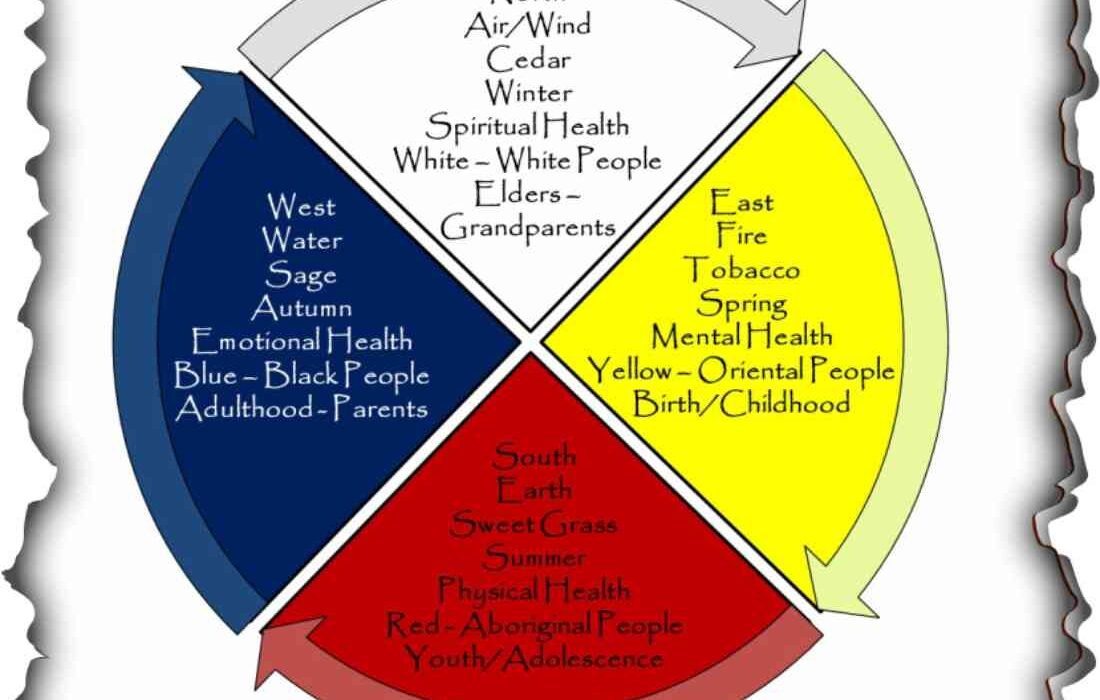A Sacred Symbol of Balance and Connection
The Medicine Wheel, sometimes called the Sacred Hoop, is a profound symbol used by many Indigenous peoples across North America. It represents balance, harmony, and the interconnectedness of all living beings. This ancient symbol serves as a guide for holistic health, spirituality, and living in harmony with the natural world.
What is the Medicine Wheel?
The Medicine Wheel is symbolized by a circle divided into four quadrants, each representing the four cardinal directions: East, South, West, and North. Each direction corresponds to specific colors, elements, animals, seasons, and stages of life. This holistic symbol guides healing, spirituality, and life teachings by emphasizing the unity and cyclical nature of all things.
Image suggestion: An illustrated Medicine Wheel showing the circle divided into four colored quadrants (commonly yellow, red, black, and white) with symbols for each direction (e.g., sun for East, plants for South).
Historical Origins and Spiritual Significance
The Medicine Wheel dates back thousands of years with archaeological evidence such as stone wheel formations marking sacred sites. It has been traditionally used by Indigenous healers and communities not only as a physical marker for ceremonies but also as a spiritual tool for meditation, healing, and teaching.
The circular shape signifies the continuous cycle of life and natural rhythms like the sun’s rising and setting, the changing seasons, and the stages of human life.
Image suggestion: Photograph or artistic rendering of an ancient stone medicine wheel formation in a natural landscape.
The Four Directions and Their Meanings
The four directions of the Medicine Wheel each hold unique spiritual and practical significance:
- East (Yellow): Symbolizes birth, new beginnings, the rising sun, and illumination. It represents childhood and the spring season.
- South (Red): Associated with growth, warmth, summer, and youth. It symbolizes trust and passion.
- West (Black): Represents introspection, maturity, autumn, and the end of life’s cycle. It reminds us of reflection and change.
- North (White): Symbolizes wisdom, elders, winter, and spiritual guidance. It represents rest, reflection, and knowledge.
Image suggestion: Quadrant-focused diagrams highlighting each direction with corresponding color, animal totem, and seasonal iconography.
The Circle of Life and Stages of Human Development
The Medicine Wheel illustrates the four stages of human life:
- Birth and Childhood (East)
- Youth and Growth (South)
- Adulthood and Responsibility (West)
- Elderhood and Wisdom (North)
This cycle represents how people move through life gaining knowledge, experience, and spiritual awareness. The teachings also emphasize respect for elders as holders of wisdom and guides for the younger generations.
Holistic Health and the Medicine Wheel
The Medicine Wheel teaches that true health encompasses more than the physical body, including emotional, mental, and spiritual wellbeing. These four dimensions correspond to the four parts of the wheel, encouraging individuals to seek balance in all areas of their life.
Traditional Indigenous healers use plants, rituals, and ceremonies guided by the Medicine Wheel’s teachings to promote harmony and healing in communities.
Contemporary Use and Interpretation
While the Medicine Wheel holds sacred traditional meaning for Indigenous peoples, it has also been adopted and adapted by various groups for personal development and spiritual growth. However, it’s essential to respect its cultural origins and understand it as a collective symbol deeply rooted in Indigenous community life rather than solely an individualistic tool.
Lessons from the Medicine Wheel
Many Indigenous teachings incorporate the Medicine Wheel as a foundation, including the seven sacred teachings such as love, respect, courage, honesty, humility, wisdom, and truth. These guide ethical and spiritual living.
Conclusion: The Medicine Wheel as a Guide to Balance
The Medicine Wheel remains a powerful symbol of interconnectedness, teaching that everything in life is connected and cyclical—from the natural world to human existence. It encourages living in balance with oneself, community, and all creation, serving as a sacred path toward healing and harmony.


